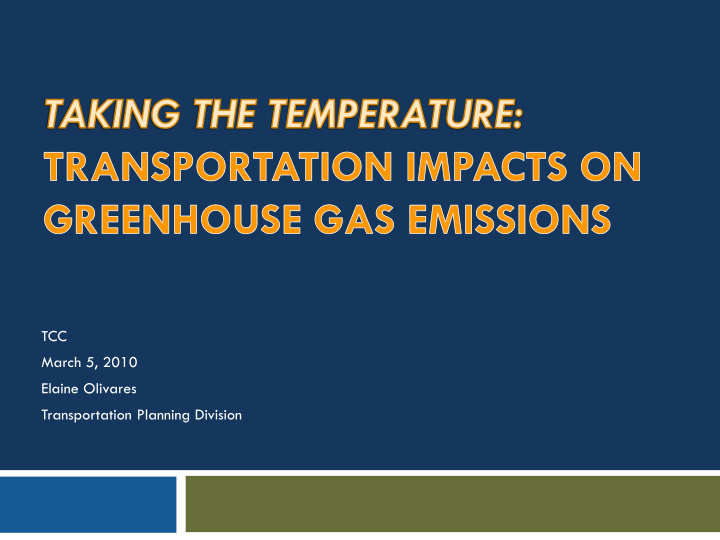



TCC March 5, 2010 Elaine Olivares Transportation Planning Division
Washington State Dept of Ecology
Purpose Possible effects of increased levels of greenhouse gas (GHG) emissions National policies are considering strategies for reducing all GHG emissions Envision6 LRTP contains strategies to reduce primary pollutants as well as GHGs Relationship to Plan 2040
Federal level Pending Legislation HR2454 American Clean Energy and Security Act SB1733 Clean Energy Jobs & American Power Act Kerry-Lieberman-Graham Bipartisan bill Regulation EPA’s Endangerment Finding EPA Mandatory GHG Reporting Rule Partnership for Sustainable Communities
Reductions must come from all sectors Georgia CO 2 emissions, 2007 U.S. CO 2 emissions, 2007 Residential Residential Commercial Commercial 4% 6% 2% 4% Industrial 9% Electric Industrial Power Electric 16% 40% Power 49% Transportation 36% Transportation 34% Source: Energy Information Administration, “Georgia Carbon Dioxide Emissions from Fossil Fuel Consumption (1980 to 2007).” Feb 2010.
Transportation Factors 1. Increasing VMT VMT & population change in metro Atlanta 70% 60% 50% 40% 30% 20% 10% VMT population 0% 1990 1992 1994 1996 1998 2000 2002 2004 2006 -10% GDOT, ARC
Transportation Factors 2. Fleet Efficiency 1990 2007 Other Other 6% 7% Light Duty Trucks Passenger Light 25% Passenger Vehicles Duty Vehicles 53% Trucks 69% 40% Bureau of Transportation Statistics
Transportation Factors 3. On-Road Freight Traffic 84% of region freight movement 55% increase in VMT between 2005 and 2030 Heavy-duty diesel engines are a primary source of CO 2 emissions ARC, Envision6
Transportation Factors 4. Congestion Low travel speeds and idling 1.35 TTI in 2007 1.64 by 2030. 3.5 3 2.5 Million Daily 2 hours 1.5 gallons of fuel 1 0.5 0 Source: Envision6 RTP 2008 2030 ARC, Envision6
Transportation Variables to Consider Vehicles Improve overall fuel economy through technology Fuel Lower carbon content or burn less VMT Drive less Operations Driver behavior and maintenance Source: Center for Clean Air Policy
Fuel Economy Improvements 50% 23 mpg 40% EISA MPG 30% 20% 10% 17 mpg 16 mpg 0% Trend MPG -10% 1990 1995 2000 2005 2010 2015 2020 2025 2030 EISA = Energy Independence and Security Act of 2007
Draft CO 2 Emissions CAFE Standards Alone Are Not Enough
Draft CO 2 Emissions Density Further Decreases Emissions
Draft CO 2 Emissions Transit + TODs Mitigate Emissions Growth
Draft CO 2 Emissions Transportation Alone Won’t Get Us There 180% Future Local Plans (Trend) 160% Envision6 140% Increase in CO 2 Emissions 120% 100% Trend + EISA 80% Envision6 + EISA Density Land Use + EISA 60% TPB Concept 3 + Transit Focused Land Use + EISA 40% C3 + TFLU + 2009 CAFE 20% 0% 1990 2000 2010 2020 2030
Future Emissions Per Capita Decrease
ARC Policies Envision6 Goals “Protect and improve environment and quality of life” “Support economic growth and development” “Sustainable and context sensitive development in urban centers and corridors with access to all modes of travel” “Traditional neighborhood development for all incomes with access to transportation options, jobs, services, and greenspace ”
ARC Policies Livable Centers Initiative
ARC Programs
State Climate Action Plans Pew Center, 10 Nov 2009
Peer regions Region Action Driven by California MPOs Analyze the GHG impacts of their State law long-range transportation plans MWCOG Set short-, mid-, and long-term COG Board (Washington DC) reduction goals of Directors PSRC (Seattle) Policies and goals outlined in State law Vision2040 RTP RTP H-GAC (Houston) Discussion of integrating GHG None Emissions/Strategies into the next RTP DVRPC Set regional goal. RTP (Philadelphia) Developed GHG inventory.
Plan 2040 Policy Recommendations for Discussion Promote sustainable development through integrated land use and transportation strategies Encourage alternative modes of transportation Support the use of cleaner and more fuel-efficient cars Work with stakeholders to set meaningful and realistic reduction targets Consider adaptation strategies
Questions? Elaine Olivares 404.463.0067 eolivares@atlantaregional.com
Recommend
More recommend